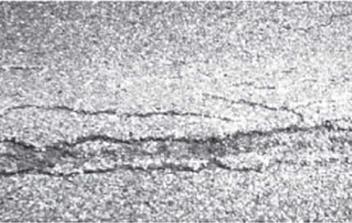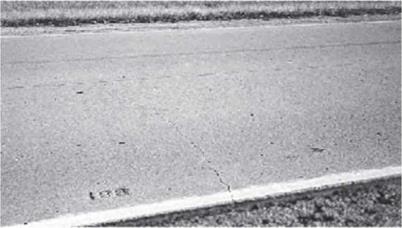Crack Sealing
Crack sealing is the placement of a sealant into existing cracks of a pavement. The sealant is made of a mixture of a neat or modified asphalt cement binder, with a number of possible additives such as rubber, polyester or polypropylene fibers, or polymers. Crack sealing can be placed into routed crack reservoirs using backer rods (see Fig. 3.6) or can be placed directly over the crack using an overband technique. Crack sealing is used to minimize the intrusion of water into the pavement. By keeping water out of the pavement, erosion of the mix is kept to a minimum, deterioration of the crack is slowed, and less water is available to saturate the base materials.
There is a wide window of opportunity for cost-effective crack sealing of flexible or composite pavements. In general, cracks that display significant raveling of the crack face and secondary branch cracking (see Fig. 3.54) need more than just a crack seal and should be considered for some other type of preventive maintenance, which may include crack sealing.
|
FIGURE 3.54 Secondary cracking of asphalt surface. |
Rigid pavements are not expected to have cracks wider than hairline. Crack sealing hairline cracks in a rigid pavement has not been shown to be cost effective (see Fig. 3.55), and will result in a noisier and rougher riding pavement. Where cracks are found to be wider than 1/8 in (3 mm) and less than 1/4 in (6 mm), crack sealing may be beneficial; however, further investigation is recommended, as more serious problems may be present.
Best practice is to select pavements that have sufficient cracking for crack sealing mobilization to be worthwhile, yet preclude excessively cracked pavements. Furthermore, pavements that require the use of crack sealing material in excess of 5000 lb/lane mile (1400 kg/lane km) are questionable candidates for crack sealing.
|
FIGURE 3.55 Hairline crack in rigid pavement. |
|
TABLE 3.28 Rubber-Asphalt Joint Sealing Compound Quantities Needed for Different Depths and Widths of Openings Pounds required per 100 lineal ft for indicated width of opening
|
Where crack sealing is not a suitable method of preventive maintenance, other forms of pavement preservation should be considered. Table 3.28 is provided for quantity estimation. The table is based on a unit material weight of 63 lb/ft3 (1000 kg/m3), and does not account for waste or spillage. This table is applicable for crack sealing materials meeting the requirements of ASTM D-6690.
Maintenance of traffic is required to apply the sealant and allow it to cure. Cure time is usually less than 1 h. Crack sealing operations are most effective when pavement temperatures are cool to cold. As pavements cool they contract, and thus widen the cracks, allowing more sealant to enter the pavement. Crack sealing should not be done on wet or damp pavements and should be applied on pavements when both surface temperature and ambient air temperature are above 40°F (4°C).
Crack sealing will have little effect on the current pavement condition. The intent of crack sealing is to slow the rate of deterioration and prolong pavement life. Crack sealants are expected to last 2 to 3 years before reapplication is necessary.








Leave a reply